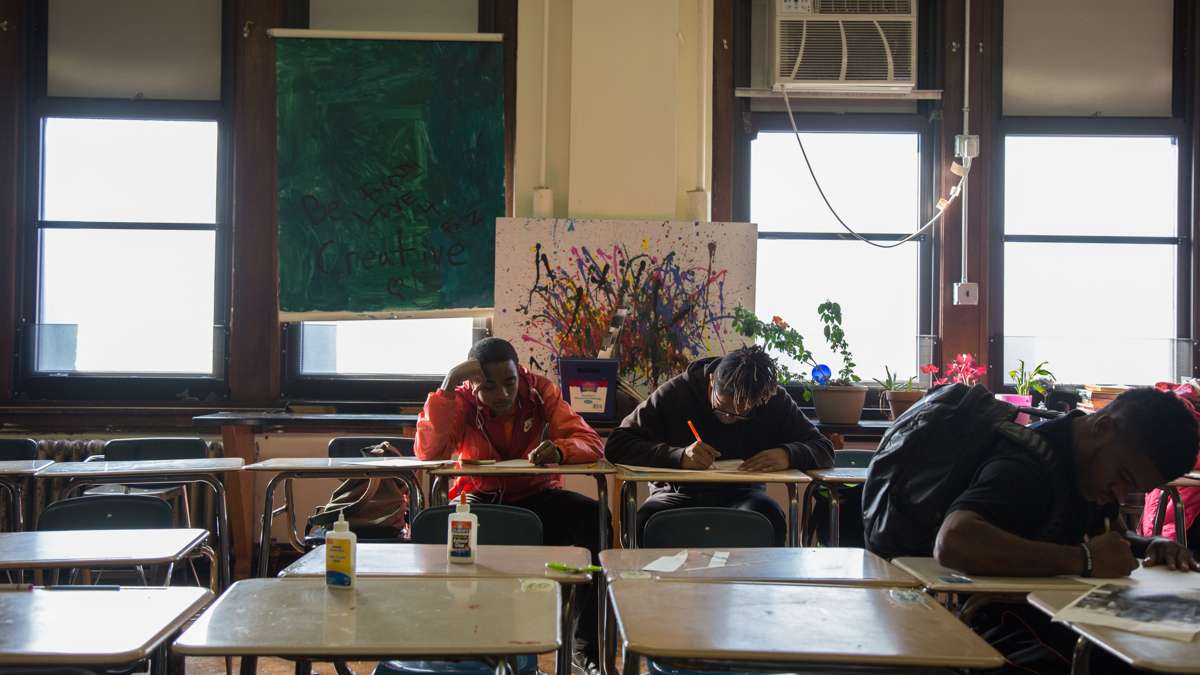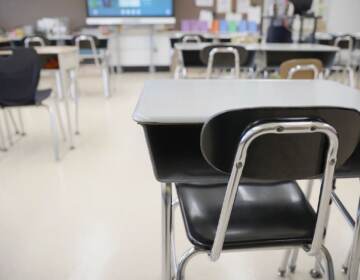Pa. lawmakers want to reform school construction program, but funding remains a question

Students at an art class in Overbrook High School in Philadelphia in 2016. State Senator Vincent Hughes has cited Overbrook as an example of a school in need of repair. (Emily Cohen for WHYY)
Pennsylvania’s system for funding school construction projects is old.
How old, you ask?
Current statute requires school districts submit their proposals in microfiche format.
“[Anything] that mentions microfiche is probably worth revisiting and looking to update,” said Pedro Rivera, Pennsylvania’s secretary of education.
Over the last two years, Rivera and a group of lawmakers from both chambers and parties have done just that: revisit Pennsylvania’s reimbursement protocol for school construction projects, known colloquially as PlanCon.
The PlanCon advisory committee released and adopted recommendations Tuesday that called for streamlining the reimbursement process and creating a carveout for schools to make needed repairs.
It did not, however, call for new money to revive the program, which hasn’t been funded since it became a casualty of the historically prolonged state budget battle of 2015.
Tuesday’s recommendations, which have yet to be introduced as a bill, focused on a few key areas. Lawmakers want to simplify the application process for districts seeking reimbursements for capital projects. They want to incentivize districts to build more energy efficient buildings. And they want to make the reimbursement rate more rational and predictable, tying it to a formula that accounts for things like district wealth.
The committee members also recommended 20 percent of all state reimbursement dollars go toward repair and maintenance. Currently, only new construction projects are eligible for state assistance. That 20 percent carveout could be boon to older, poorer districts with crumbling infrastructure and less capacity for building new schools.
“The commonwealth has a unique opportunity to dramatically improve the efficiency of one of its most complex financing programs,” said State Senator Pat Browne (R-Lehigh), co-chair of the advisory committee and chair of the Senate Appropriations Committee.
The lingering question, though, is whether there will be any money to back up the reforms.
In 2012, the legislature began to limit the flow of applications from school districts seeking reimbursements. There’s now a moratorium on applications, and in 2015-16 the state stopped funding PlanCon, zeroing out a budget line that had reached more than $300 million annually.
The state recently borrowed $850 million to cover outstanding payments owed to school districts who received approval before the moratorium began. There are, however, no new projects in the pipeline.
Funding absent
Tuesday’s report did not ask the legislature to appropriate money for school construction or list a recommended amount if the state decides to revive the program. Some committee members wanted dollars attached to the recommendations.
“In the end, you’ve got to attach the dollars to do it,” said State Senator Vincent Hughes, (D-Philadelphia). “Getting the structural changes kind of gets you halfway there. Now you’ve got to put the money into it.”
Across the country, there’s no consensus on what role states should play in funding school construction projects.
Nineteen states provide zero capital dollars, six cover more than half of capital expenditures in their respective states, and the rest fall somewhere in-between, according to the committee’s report. Nationally, states cover 18 percent of school capital costs, according to a 2016 report from the 21st Century School Fund.
Pennsylvania began providing school construction reimbursements in the 1950s, and the current reimbursement system took shape in the early 1970s — hence the microfiche. Since the 1979-80 school year, Harrisburg has chipped in $8.1 billion to help build new facilities. Between 2010 and 2015, the state doled out an average of $301 million annually before turning off the spigot altogether.
Even when the state was funding PlanCon, some cash-strapped districts, like Philadelphia, fell woefully behind on basic maintenance. A recent internal analysis found that Philly schools need nearly $5 billion in maintenance. That number was based on a detailed inventory of the district’s building stock, which helped inform a withering investigative series on the state of Philadelphia’s schools written by The Philadelphia Media Network.
The PlanCon advisory committee’s report includes a small incentive for districts to conduct their own building inventories and publish the results on a state site, offering a slightly better chance approval and slightly higher reimbursement rate.
The plan would also require the state department of education to create guidelines for districts choosing to conduct facilities assessments.
More data on building conditions could theoretically spur more media coverage and public pressure. But the committee stopped short of requiring a statewide facilities index despite a push from some members, including Hughes.
Philadelphia’s assessment of its own buildings has prompted considerable attention, but local leaders don’t seem to think it will prompt a substantial response from Harrisburg.
Instead, Philadelphia Mayor Jim Kenney is calling for a local property tax hike to help improve conditions in the city’s aging schools.
WHYY is your source for fact-based, in-depth journalism and information. As a nonprofit organization, we rely on financial support from readers like you. Please give today.






